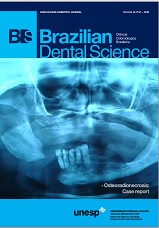Replacement of fractured amalgam restoration in shallow cavities using a new category of adhesive system: case report
DOI:
https://doi.org/10.14295/bds.2015.v18i2.1087Abstract
Introduction: Several failure have been related in amalgam restorations that requiring repair or replacement. Objective: The aim of this case report was to demonstrate a usual clinical condition found in dental office: fractured in amalgam restorations associated with the esthetic patient desire. Case report: Then, seven fractured amalgam restorations replacements, probably due to improper cavity design, were performed in two patients. The replacements were accomplished by three different operators. It was applied a “multi-mode” adhesive system using the selective enamel etching technique and a nanofilled resin composite with good mechanical proprieties and polishing. At the end, satisfactory esthetic results were achieved for all restorations. However, differences among operators were detected, highlighting the importance of professional training and esthetic desire. Conclusion: Thus, it was conclude that the resistance and retention form of amalgam design was the major concern on the failed amalgam restorations in this study. In addition, amalgam restorations must be replaced carefully to avoid damaging the dental remaining, and the resin composite has been selected as a preferred option for amalgam replacement, since it is more conservative and esthetic.
Downloads
Downloads
Additional Files
Published
How to Cite
Issue
Section
License
Brazilian Dental Science uses the Creative Commons (CC-BY 4.0) license, thus preserving the integrity of articles in an open access environment. The journal allows the author to retain publishing rights without restrictions.
=================




























